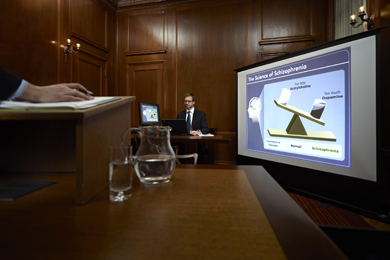Trial Presentation Trusted Professionals for Legal Visuals and Graphics
Trial Presentation Trusted Professionals for Legal Visuals and Graphics
Blog Article
Mesmerize the Jury: Necessary Components of a Powerful Trial Discussion
Essential elements such as recognizing the audience, crafting a compelling story, and grasping spoken and non-verbal communication are crucial components of a reliable discussion. As these variables link, they form a natural method that not only informs but additionally engages jurors on several levels.

Understanding Your Target Market
Comprehending your target market is a critical element of efficient trial discussion. A successful discussion rests on the capacity to grasp the demographics, worths, and tendencies of jurors. This comprehension notifies exactly how arguments are mounted, evidence is offered, and sob stories are crafted, ensuring that the message reverberates with the jurors on an individual level.
Research indicates that jurors come from varied histories and might have varying levels of comprehending relating to lawful procedures (trial presentation). Hence, it is crucial to avoid lawful jargon that might alienate or confuse them. Instead, employing clear, relatable language promotes engagement and understanding. Furthermore, recognizing the jurors' possible predispositions and life experiences permits the test presenter to expect objections and address worries proactively.
Effective trial discussion additionally involves observing jurors' reactions during the procedures. Being in harmony with non-verbal hints can give insight right into their involvement and receptivity, permitting real-time modifications in method. Eventually, a profound understanding of the audience not just improves communication but additionally develops relationship, boosting the possibility of a desirable end result. Engaging with jurors as individuals instead of a collective unit is important in cultivating a solid connection in the court room.

Crafting a Compelling Story
Crafting a compelling story is essential in leading jurors via the intricacies of an instance. A well-structured narrative not just simplifies intricate lawful ideas however likewise engages jurors on an emotional level, making the information extra relatable and memorable.
To achieve this, lawyers need to start by determining the core message they desire to communicate. This message ought to resonate with the jurors' values and experiences, fostering a connection that goes beyond mere facts. The narrative must unravel practically, presenting events in a clear sequence to stay clear of complication. This chronological method can help jurors follow the development of occasions, stressing domino effect.
Incorporating human aspects-- such as personal stories or anecdotes-- can additionally boost the story's effect. These elements stimulate compassion, enabling jurors to imagine the consequences of the instance on realities. Additionally, using a consistent theme throughout the discussion reinforces the major disagreement, making it simpler for jurors to retain crucial points.
Ultimately, an engaging narrative changes a trial presentation from a simple recitation of truths right into a convincing story that mesmerizes the court, encouraging them to deliberate with both factor and emotion.
Using Aesthetic Help
Incorporating aesthetic aids into a trial discussion can significantly boost jurors' comprehension and retention of details. Visual materials such as charts, layouts, photos, and video clips can transform complicated legal principles and evidence into his explanation quickly digestible styles. By involving multiple detects, these aids allow jurors to picture the situation's vital components, making it simpler for them to adhere to along and comprehend detailed information.
Furthermore, well-designed visual aids can stress crucial points and emphasize relationships between different items of evidence. Timelines can successfully highlight the sequence of events, while annotated pictures can clear up certain details relevant to the case. This not just help in understanding but additionally reinforces the story provided by the lawyer.
Excessively complex or messy visuals might bewilder jurors and detract from the message. Eventually, reliable aesthetic interaction can be an effective tool in convincing jurors and assisting them reach informed final thoughts.
Grasping Verbal Communication
Reliable spoken interaction is critical in a test discussion, as it offers as the primary ways via which attorneys communicate their debates and link with jurors. Grasping this skill includes clearness, persuasion, and engagement. Lawyers should articulate their points clearly and concisely, staying clear of lawful lingo that might confuse jurors. Simpleness in language cultivates understanding and aids jurors comprehend complex problems provided during the trial.
Moreover, tone and pacing substantially effect exactly how messages are obtained. A positive tone communicates authority, while appropriate pacing permits jurors to take in information without really feeling bewildered. Attorneys should additionally vary their singing inflections to stress bottom lines and keep jurors' rate of interest throughout the presentation.
In addition, the organization of spoken disagreements is vital. Structuring the narrative realistically and coherently helps jurors adhere to the attorney's logic, making it less complicated for them to maintain vital information. Making use of convincing techniques, such as narration, can also boost the emotional vibration of the arguments offered, consequently creating a more extensive connection with jurors.
Ultimately, understanding verbal interaction not only enhances a lawyer's case but also cultivates count on and relationship with the jury, dramatically improving the opportunities of a beneficial decision.

Involving With Body Language
Nonverbal interaction plays an essential role in test presentations, typically communicating messages that words alone can not reveal. Body movement, incorporating gestures, stance, faces, and eye get in touch with, dramatically influences just how jurors view the trustworthiness and genuineness of the presenter. A certain stance, with shoulders back and an open stance, can impart trust fund, while closed-off body language might suggest defensiveness or unpredictability.

Faces ought to mirror the feelings related to the instance, enhancing the story existing. As an example, a genuine expression throughout an emotional minute see here can evoke compassion and strengthen the sob story. Inevitably, understanding body movement is vital for reliable trial discussions, as it enhances spoken interaction and establishes a compelling visibility that resonates with the court.
Verdict
To conclude, mesmerizing the jury necessitates a tactical technique that incorporates understanding the audience, crafting an engaging story, making use of visual aids, grasping spoken interaction, and involving through body language. Each aspect plays an essential function in creating an effective trial important link presentation that resonates with jurors on both emotional and intellectual degrees (trial presentation). By incorporating these parts efficiently, lawyers can substantially improve their capacity to persuade and influence jury decision-making
Report this page